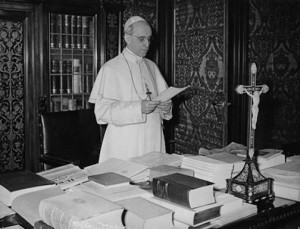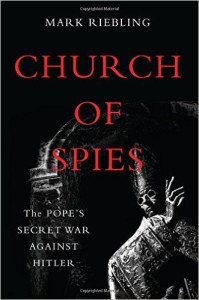The world has had to endure the false charge – ever since Rolf Hochhuth’s 1963 play The Deputy – that Pope Pius XII was “Hitler’s pope.” Informed people have suspected for decades that this was a deliberate distortion, but we now know beyond all doubt that such charges were not only wrong, they are the exact opposite of the truth.
When Cardinal Eugenio Pacelli became Pius XII in 1939, Nazi SS chief Heinrich Himmler ordered Albert Hartl, a defrocked Catholic priest, to prepare a dossier on the new pope. Hartl documented how Pacelli had used the Concordat he had negotiated with Hitler’s new government in 1933 to the Church’s advantage, complaining formally to Hitler at least fifty-five times about violations.
Pacelli had also accused the Nazi state of plotting to exterminate the Church, and “summoned the whole world to fight against the Reich.” Worse yet, Pacelli preached racial equality, condemned “the superstition of race and blood,” and rejected anti- Semitism. Quoting a fellow SS officer, Hartl concluded, “at issue was not whether the new pope would fight Hitler, but how.”
Meanwhile, Pius was holding meetings with German cardinals discussing the Hitler problem. Transcripts reveal that Pius complained that: “The Nazis had thwarted Church teachings, banned its organizations, censored its press, shuttered its seminaries, seized its properties, fired its teachers and closed its schools.” He quoted a Nazi official who boasted that “After the defeat of Bolshevism and Judaism, the Catholic Church will be the only remaining enemy.”
Munich’s Cardinal Michael von Faulhaber charged that the troubles began after the 1937 encyclical With Burning Anxiety (Mit Brennender Sorge, published in German, not Latin). The text, partly written by Pacelli before he became pope, infuriated Hitler. The pope commented to Faulhaber, “The German question is the most important for me. I am reserving its handling to myself. . . .We cannot give up on principle. . . .When we have tried everything and still they absolutely want war, we will fight back. . . .If they refuse, then we must fight.”
Faulhaber recommended “backstairs intercession.” He proposed German bishops “find a way to send Your Holiness timely and exact intelligence.” Breslau’s Cardinal Adolf Bertram added, “We have to do it clandestinely. When St. Paul had himself lowered over the city wall at Damascus in a basket, he didn’t have permission from the police either.” The pope agreed.
Thus was hatched a plan to construct an espionage network that would support, among other things, plots to assassinate Hitler.
In his riveting book Church of Spies: The Pope’s Secret War Against Hitler, Mark Riebling uses newly released Vatican files and secret transcripts, vividly describing the cloak-and-dagger tactics Pius XII employed to help bring down the Nazi regime.
After Hitler invaded Poland in 1939, the pope reacted to reports of atrocities against Jews and Catholics. His encyclical, Darkness Over the Earth, rejected racism on the grounds that the human race is unified in God. And it denounced attacks on Judaism.
The pope received universal acclaim for this – a New York Times headline read “Pope Condemns Dictators, Treaty Violations, Racism” – but did not believe it was enough.
Convinced that the Nazi regime met the necessary conditions for tyrannicide spelt out in Church teaching, Pius allowed Jesuits and Dominicans, who reported directly to him, to assist in covert actions. His key operative – the Gestapo called him “the best agent of Vatican intelligence” – was Josef Muller, an attorney and World War I hero.
Muller organized a network of like-minded “army, college and law school friends with access to Nazi officials who worked in newspapers, banks and even [in] the SS itself.” They supplied the Vatican with vital information, including battle plans that were passed on to the Allies. In 1942, Muller managed to slip Dietrich Bonhoeffer into the Vatican in order to plan a strategy “aimed at bridging interfaith gaps, so that Christians could coordinate their fight against Hitler.”
Assassination attempts on Hitler failed due to what Muller called “luck of the devil.” But Riebling remarks of those efforts: “All roads truly led to Rome, to the desk with a simple crucifix overlooking the fountains on St. Peter’s Square.”
After the 1944 Valkyrie plot failed, the Gestapo arrested Muller. They discovered a note on papal stationery by the pope’s top aide (Father Leiber) that stated, “Pius guaranteed a just peace in return for the ‘elimination of Hitler.’”

Muller was shipped off to Buchenwald. On April 4, 1945, Muller, along with Bonhoeffer, was transferred to Flossenburg. After a mock trial, they were condemned to death.
Bonhoeffer was executed immediately. But fearful of approaching American troops, the SS transferred Muller and other prisoners, to Dachau, then Austria, and finally northern Italy. They were liberated by the U.S. 15th Army.
American intelligence officers took Muller to the Vatican. The overwhelmed pontiff embraced him and said he felt “as if his own son had returned from terrible danger.”
Riebling reveals that during Muller’s Vatican visit, U.S. diplomat Harold Tillman asked why Pius had not spoken out more during the war:
Muller said that during the war his anti-Nazi organization in Germany had always been very insistent that the Pope should refrain from making any public statement singling out the Nazis and specifically condemning them and had recommended that the Pope’s remarks should be confined to generalities only. . . .if the Pope had been specific, Germans would have accused him of yielding to the prompting of foreign powers and this would have made the German Catholics even more suspected than they were and would have greatly restricted their freedom of action in their work of resistance to the Nazis. Dr. Muller said the policy of the Catholic resistance inside Germany was that the Pope should stand aside while the German hierarchy carried out the struggle against the Nazis inside Germany. Dr. Muller said the pope had followed this advice throughout the war.
Thanks to Riebling’s exhaustive research, we’re now able to put to rest forever the absurd claims about Pius XII. He wasn’t “Hitler’s pope;” he was Hitler’s nemesis.
You can buy Church of Spies from The Catholic Thing store at Amazon by clicking here.















